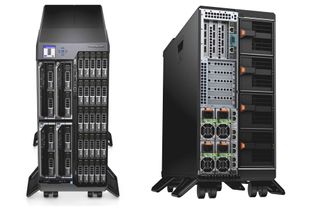IT Pro Verdict
SMBs and remote offices looking to consolidate IT services on a single hardware platform should consider Dell’s new PowerEdge VRTX. It’s far more affordable than a blade server and its unique storage and PCI-e shared architecture makes it very versatile.
Pros
- +
Clever design; More affordable than blade servers; Low noise and power consumption; Excellent remote management
Cons
- -
It’s heavy so get the wheels for the pedestal model
Blade servers are ideal for amalgamating IT services onto a single hardware platform but are an expensive option for SMBs. In this exclusive review we look at Dell's new PowerEdge VRTX which aims to offer a lower-cost and more flexible alternative.
The VRTX targets SMBs and remote offices that want to consolidate all their IT services onto a single system. It's designed to operate in normal office environments without the need for additional cooling or sound proofing.
Blade server aficionados will compare the VRTX to HP's C3000 Shorty' and Fujitsu's Primergy BX400 but these two systems are a lot more expensive. They also employ classic blade server architecture for I/O and storage provisioning and neither can match Dell's storage and PCI-e sharing design.
Offered as a floor standing pedestal with wheels or a 5U rack chassis, the VRTX supports up to four hot-plug server nodes. You can choose from the M520 and M620 nodes used by Dell's PowerEdge M1000e blade server but they aren't interchangeable as the VRTX models use a different firmware.

All storage can be shared with the server nodes and the chassis provides high levels of redundancy
Innovative design
The chassis uses a passive mid-plane to connect the nodes to networking, power, storage and management services. Each node has an embedded PERC H310 RAID controller and two SFF drives but main storage is provisioned from the drive bays alongside.
Up to 12 LFF or 25 SFF drive bays can be ordered and these are managed by the shared PERC8 (SPERC8) on the chassis planar. Using the chassis web management interface, you select drives from the pool and create virtual disks each with their own RAID array type. These are then assigned to a virtual adapter which is, in turn, assigned to a node slot.
When the node is powered up it sees the SPERC8 and the virtual drive as local storage. This makes the VRTX more flexible than blade servers which must rely either on local node storage, additional disk blades installed in the chassis or SAN links using mezzanine cards and proprietary I/O modules.

Shared storage is managed by the embedded SPERC8 controllers and the PCI-e slots can be assigned to any server node
Dave is an IT consultant and freelance journalist specialising in hands-on reviews of computer networking products covering all market sectors from small businesses to enterprises. Founder of Binary Testing Ltd – the UK’s premier independent network testing laboratory - Dave has over 45 years of experience in the IT industry.
Dave has produced many thousands of in-depth business networking product reviews from his lab which have been reproduced globally. Writing for ITPro and its sister title, PC Pro, he covers all areas of business IT infrastructure, including servers, storage, network security, data protection, cloud, infrastructure and services.



